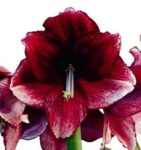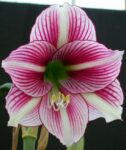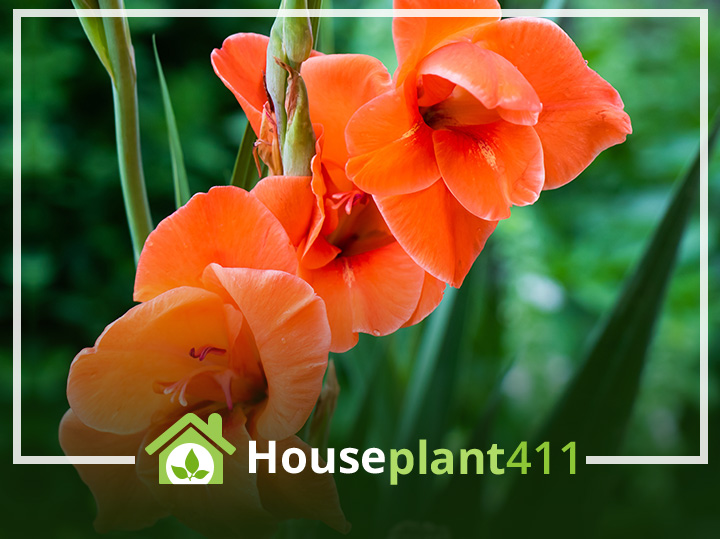About
An Amaryllis plant is a member of the Amaryllidaceae family and belongs to a very small genus of flowering plants that have only two varieties. The better-known variety, and the one we use as an indoor plant, is the Amaryllis belladonna. This variety was originally found growing on the western cape of South Africa. Amaryllis Belladonia is sometimes called a Belladona Lily, Barbados Lily, or a Jersey Lily because the plant flowers look very similar to a lily. In Australia, an amaryllis plant is called an Easter Lily plant and in South Africa is called a March Lily plant. This is because in the southern hemisphere, an amaryllis plant blooms around March in time for Easter. In the northern hemisphere, it blooms in December and January in time for the Christmas and New Years holidays. Although the amaryllis plant flower does resemble a lily flower both in the way it grows and in its shape, an amaryllis plant is really a very distant cousin of the true lily plant. Amaryllis plant bulbs can be planted (or purchased pre-planted) from October through the end of April. Those that bloom in late November, December, and early January are known as early or Christmas time amaryllis. The late blooming bulbs develop flowers in late January and through March.
Description
Amaryllis plant bulbs can be planted (or purchased pre-planted) from October through the end of April and will bloom anywhere from late November to January in the northern hemisphere. The spectacular amaryllis flowers range in size from 4”- 10.” When buying amaryllis bulbs, remember it is the large, healthy bulbs that produce the larger flowers. Amaryllis flowers can be singles or doubles and come in many colors such as red, white, rose, dark reddish/burgundy, orange, and apricot. New amaryllis plant varieties produce bicolored flowers and flowers with different edge colors. With proper after-bloom care, the easy care Amaryllis plant will flower year after year for many years.
Amaryllis Plant Varieties




A. Daphne A. Meerow A. Double White A. Aphrodite
How to Get an Amaryllis Plant to Re-Bloom
Once the flowers of your Amaryllis plant start to die, cut them off at the top of the stem, but do not remove the leaves on the stem.
Keep your plant in a bright spot and continue to water as needed.
When the stems begin to droop cut them back to the top of the bulb.
Continue to water and fertilize all summer or at least 5-6 months, allowing the leaves to grow; this provides nourishment for the bulb.
When the leaves start to turn yellow, prune the plant to about 2″ from the top of the bulb. This is usually during the early fall.
Remove the bulb from the soil. Clean the bulb and place it in a cool dark area, 40°-50°F (4.4°-10.0°C) for a minimum of six weeks. The refrigerator is okay if there are no apples in it. Apples sterilize amaryllis bulbs and prevent new growth.
After the bulbs have rested, replant them and move your amaryllis to a warm, bright area. Plant the bulbs about eight weeks before you want them to bloom. It will take longer for an amaryllis to rebook in the winter than in the spring.
Is an Amaryllis Plant Poisonous
Amaryllis plants are considered very poisonous and should be kept away from dog, cats, and small children. Read more about common houseplants that can be dangerous in my book Don’t Feed Me to Your Cat: A Guide to Poisonous Houseplants.
Plant Care
Light
HOW MUCH LIGHT FOR AN AMARYLLIS PLANT: Bright indirect but not direct afternoon sun is ideal for an amaryllis plant. Turn the plant each time you water keep the stems growing straight up and not leaning toward the light.
Water
HOW TO WATER AN AMARYLLIS PLANT: Water the bulbs sparingly until the stems appear. As the stem, flower buds, and leaves develop increase the water. Keeping the soil barely moist helps extend the life of the flowers.
Fertilizer
HOW TO FERTILIZE AN AMARYLLIS PLANT: Feed monthly with a plant food high in potassium and phosphorus and low in nitrogen. Always dilute the plant food to 1/2 the recommended strength.
Temperature
BEST TEMPERATURE FOR AN AMARYLLIS PLANT: These plants like temperatures between 68°-70°F(20°-21.1°C). Once the plant flowers moe it to a slightly cooler area to help the flowers last longer.
Humidity
HOW MUCH HUMIDITY FOR AN AMARYLLIS PLANT: Basic household humidity is all this plant requires.
Flowering
You can plant amaryllis bulbs from late fall through the spring. The larger and healthier the bulbs are, the bigger the flowers will be (and the sicker your dog or cat with be if they eat one). Soak the base of the bulb and cheroots for a few hours before planting. It takes about 7-10 weeks from the time you planted the bulbs for an amaryllis to flower.
Pests
AMARYLLIS PLANT PESTS: Treat thrips and spider mites with the non-toxic homemade Green Solution, recipe is in the Glossary. Use Yellow Sticky cared to trap fungus gnats.
Diseases
AMARYLLIS PLANT DISEASES :Fungal and bacterial diseases cause blotchy leaves. Provide good air circulation and keep the leaves of an amaryllis plant dry.
Soil
SOIL FOR AN AMARYLLIS PLANT: Use a commercial bulb soil of a quick draining potting mixture. Try to find a sterile mix which will help prevent pest problems. Fill the container about half way with moist soil. Place the bulb or bulbs (1″ apart) on top of the soil. Add additional soil, but remember to leave about the top 1/4-1/3 third of the bulb above the soil line.
Pot Size
POT SIZE FOR AN AMARYLLIS PLANT: Like many houseplants, an amaryllis likes to be a little root- bound in a small pot. However, since amaryllis plants have tall stems and large flowers, use a heavy, wide pot that will help the plants grow straight up. There should be about 2″ of soil around the bulb. When planting multiple bulbs in one pot, place them about 1″ apart. If you are planting several bulbs in one container they can be planted about an inch apart.
Propagation
HOW TO PROPAGATE AN AMARYLLIS PLANT: The best way to propagate an amaryllis plant is to use the offsets that develop around the base of the plant or to divide the bulbs. You can read more about these propagation techniques in the Glossary of the website.
Resting Period
A resting period for an amaryllis plant is very important if you hope to get it to flower again the following year. Following instructions above and you’ll have a beautiful blooming plant year after year.
Special Occasion
Amaryllis plants are wonderful gifts especially around Thanksgiving and Christmas.
Poisonous Plant Info
IS AN AMARYLLIS PLANT POISONOUS: This plant is extremely poisonous to small children, dogs, cats and other pets.. All parts of the plant contain alkaloids that can cause severe problems if the plant is ingested. The amaryllis bulbs contain calcium oxalates and are the most dangerous part of the plant. Pets that swallow pieces of an amaryllis plant suffer severe mouth pain, drooling, foaming at the mouth, vomiting, and breathing problems. Small children who eat any part of the plant develop digestive problems and swelling of the lips, tongue and airways making it difficult to breathe and swallow.
FAQ
Here are a few reasons why your Amaryllis may not be producing flowers: Using the wrong plant food. fertilizers high in nitrogen help with leaf production but do not help flowers develop. Use a plant food high in Potassium. Your Amaryllis may not be getting enough light or the temperature may be too cold. The soil is too wet. If you dig up Amaryllis bulbs too early once the flowers fade; the plant may not bloom the following year.
The spots on the leaves, petals, and stems of your Amaryllis plant are caused by plant disease called red blotch. To eliminate red blotch, reduce your water, keep the leaves dry, remove any diseased leaves and petals as soon as they appear, and spray your plant with a commercial Fungicide.
Your Mom’s Amaryllis plant probably started out as large, plump bulbs while you bought small ones. The larger an Amaryllis bulb the more flowers it produces. Be sure to fertilize your Amaryllis while it is still a flowerless, green plant and give it plenty of very bright light.
An indoor Amaryllis plant rarely gets plant pests. If you put the plant outdoors when the weather gets warm, it may attract a few grasshoppers.

